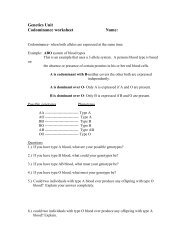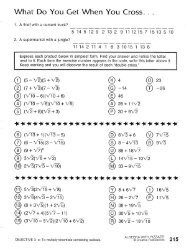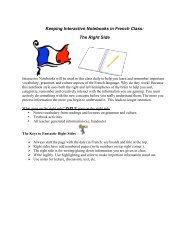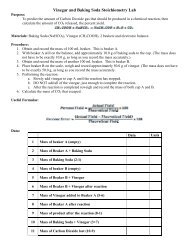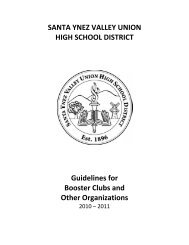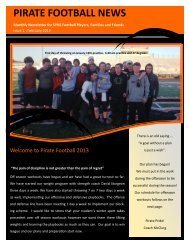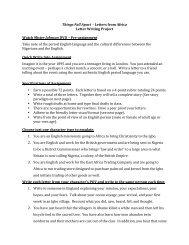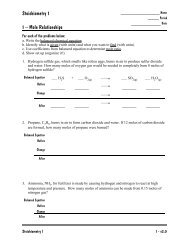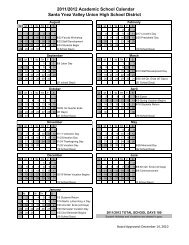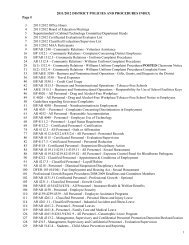Human Pedigree Problems (PDF)
Human Pedigree Problems (PDF)
Human Pedigree Problems (PDF)
You also want an ePaper? Increase the reach of your titles
YUMPU automatically turns print PDFs into web optimized ePapers that Google loves.
Sex linked recessive genes<br />
<strong>Human</strong> <strong>Pedigree</strong> Genetics Problem Set<br />
Genes carried on the X chromosome have a distinctive pattern of inheritance. Because males are<br />
hemizygous, i.e. they have only one copy of the X chromosome, and because the Y chromosome<br />
carries very few genes (though those which it carries are often homologous to X linked genes)<br />
then recessive mutations manifest themselves in the phenotype of males. If the mutant gene is<br />
lethal (such as Duchenne Muscular Dystrophy) then it takes an unusual event to produce an<br />
affected female.<br />
An X linked pedigree<br />
Problem 1: A human geneticist determined the pedigree shown in the diagram with filled<br />
symbols showing the affected individuals. How is this pattern of inheritance described?<br />
Example: A hypothetical pedigree for this family, showing heterozygous carriers in both the<br />
parental and grandparental generations, is shown in the diagram. This demonstrates the use of<br />
markers for identifying heterozygotes.<br />
1
Problem 2: The accompanying pedigree is for a rare, but relatively mild, hereditary disorder of<br />
the skin.<br />
a. Is the disorder inherited as a recessive or a dominant phenotype? State reasons for your<br />
answer.<br />
b. Give genotypes for as many individuals in the pedigree as possible. (Invent your own defined<br />
allele symbols.) Consider the four unaffected children of parents III-4 and III-5. In all four-child<br />
progenies from parents of these genotypes, what proportion is expected to contain all unaffected<br />
children?<br />
Problem 3: Consider the accompanying pedigree of a rare autosomal recessive disease, PKU.<br />
a. List genotypes of as many of the family members as possible.<br />
b. If individuals A and B marry, what is the probability that their first child will have PKU?<br />
c. If their first child is normal, what is the probability that their second child will have PKU?<br />
d. If their first child has the disease, what is the probability that their second child will be<br />
unaffected?<br />
2
Problem 4: Here are four human pedigrees. The black symbols represent an abnormal<br />
phenotype inherited in a simple Mendelian manner.<br />
a. For each pedigree, state whether the abnormal condition is dominant or recessive. Try to state<br />
the logic behind your answer.<br />
b. For each pedigree, describe the genotypes of as many persons as possible.<br />
Problem 5: The following is a complex pedigree for two traits, red hair and body hair.<br />
What are the genetic basis of these traits. Are they related to each other.<br />
3
. Do you think that the red-hair allele is common or rare in the population as a whole?<br />
Problem 6: The accompanying pedigree was obtained for a rare kidney disease.<br />
a. Deduce the inheritance of this condition, stating your reasons. b. If individuals 1 and 2 marry,<br />
what is the probability that their first child will have the kidney disease?<br />
Problem 7: Consider the accompanying pedigree of a rare autosomal recessive disease, PKU.<br />
4
a. List genotypes of as many of the family members as possible.<br />
b. If individuals A and B marry, what is the probability that their first child will have PKU? If<br />
their first child is normal, what is the probability that their second child will have PKU? If their<br />
first child has the disease, what is the probability that their second child will be unaffected?<br />
Problem 8: Which best describes the genetics of the afflicting allele in the following pedigree<br />
(it is a pedigree of taste blindness)?<br />
Problem 9: Albinism is inherited as an autosomal recessive. In the figure below, assuming that<br />
persons from the general population are not heterozygous for albinism (Aa), what are the<br />
genotypes of all persons whose genotypes are known? (i.e., indicate the genotypes on the figure<br />
for all known AA, Aa, and aa individuals)<br />
5
Tutorial: Using RFLP-analysis to hunt for human genes<br />
RFLPs, or "restriction fragment length polymorphisms", is a term to describe different alleles of<br />
a genetic locus that can be distinguished by Southern hybridization. Consider a simple example<br />
of two different alleles for human ß-globin. The normal allele has three restriction enzyme<br />
cleavage sites, but a mutation that causes sickle-cell anemia also results in an allele that has only<br />
two cleavage sites. As shown in the figure below, the two different alleles display different<br />
patterns following gel electrophoresis and Southern hybridization.<br />
Sickle-cell anemia is an autosomal, recessive human disease. A hypothetical pedigree for parents<br />
each heterozygous for the sickle-cell allele is shown in the figure below. The inheritance of the<br />
normal and sickle-cell allele in this family can be followed by RFLP-analysis. Each of the<br />
different genotypes, homozygous normal (AA), heterozygous carrier (Aa), and homozygous<br />
recessive with sickle-cell anemia (aa) can be identified by RFLP analysis.<br />
6



